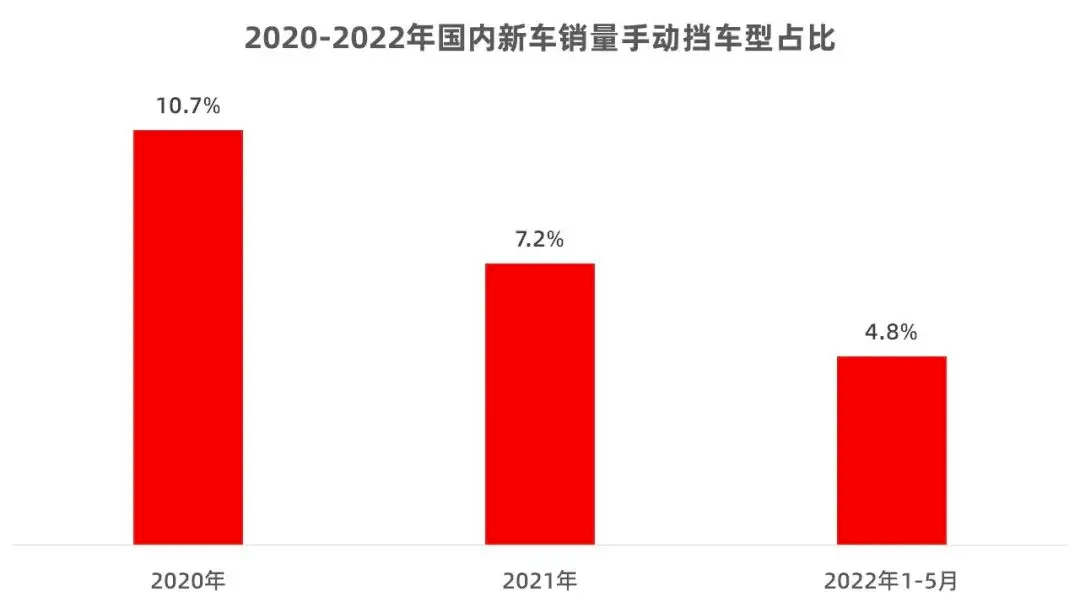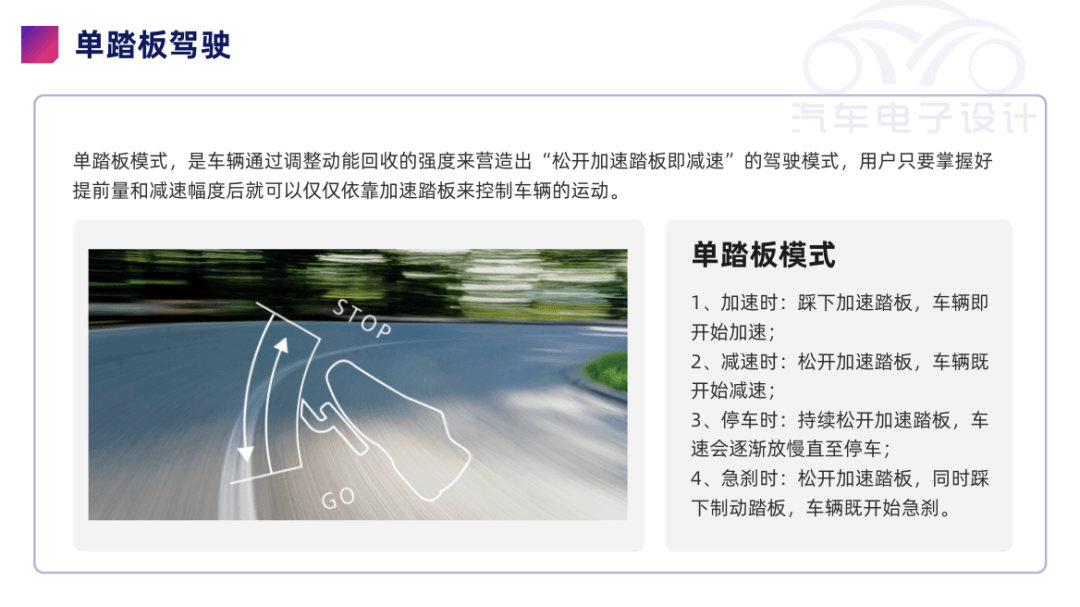The One Padel mode of electric vehicles has always been a hot topic. What is the necessity of this setting? Could this feature be easily disabled, causing an accident? If it is not a problem with the design of the car, are all accidents the responsibility of the car owner himself?
Today I want to sort out the energy recovery of the car and the design of the One Padel mode.
Remarks: A quarrel can’t make a name for itself. It’s more important for more people to understand something valuable.
Part 1
What is one-pedal mode
For most tram owners, the term “single-pedal mode” is no stranger. Here is a brief explanation: what we often call “single-pedal mode” refers to the acceleration and braking functions that can be accomplished mainly by the accelerator pedal. Step on the gas pedal to accelerate, release the gas pedal to slow down.
Looking back at the development of the car pedal, just like the law of human invention, the operation of the car is getting simpler and simpler. In the era of manual shifting with gearboxes, the power control of a car depends on three pedals: clutch, brake and accelerator. At that time, starting uphill with gasoline and electricity was a nightmare for all novice drivers. When the vehicle enters the era of automatic transmission and the clutch pedal is eliminated, the nightmare is much less.

The advent of the era of electric vehicles has brought further possibilities for streamlined design. Due to the working characteristics of the drive motor, the positive output can accelerate the vehicle, and the reverse output can brake the vehicle. This braking method makes it possible to control acceleration and deceleration with one pedal.
Of course, the brake pedal has not been completely canceled, because it is impossible to complete emergency braking by motor control alone.

Part 2
Why the misuse of one-pedal mode is under fire
In the era of traditional cars, misuse of vehicles also occurs, but such accidents often do not attract too much attention. There are three main reasons:
First, the responsibility for traditional car accidents is clear, and it is not easy to cause disputes : because traditional cars have clear functions, once misuse occurs, the responsibility basically lies with the owner. This is nothing to discuss. Of course, sometimes it is indeed a problem with the vehicle itself. At this time, the way to deal with it is that the car company assumes full responsibility and economic losses and initiates a recall.
Second, the division of responsibilities for new things has not yet been concluded : when a new functional design is misused, everyone is very concerned about whether the design is correct? Have you considered functional security issues during design? And how to divide the responsibility-is it the car owner or the car company?
The third is that in the single-pedal mode, once it is misused, it will cause greater damage than traditional cars . This is naturally easy to attract everyone’s attention. Why would it hurt more? This is related to the characteristics of electric vehicles:
◎ First of all, the energy recovery characteristics of electric vehicles will cultivate some special car habits of car owners, which makes trams more prone to accidental stepping.
In the “single-pedal mode”, the driver’s right foot basically does not move, because the braking strength of up to 2.5m/s2 can be obtained just by releasing the accelerator pedal, which can cope with most scenarios that require braking. Therefore, when encountering an emergency, some car owners subconsciously think that the accelerator pedal can be braked, and people’s instinctive reaction will make people take action. This makes tragedy more likely to happen.
The fact that similar accidents in Tesla are higher than other electric vehicles can also prove this point from the side. Because many new energy vehicles only have a certain amount of energy recovery and are not set as a real One Pedal, so the accelerator pedal cannot be used completely.
◎ Secondly, electric vehicles are more powerful and powerful than gasoline vehicles when accelerating.
For fuel vehicles, even if the accelerator pedal is stepped on by mistake, the engine speed will rise sharply at first, and when it reaches more than 4,000 rpm, it will take a certain period of time for the gearbox to downshift before it can output high torque. At this time, the car had not accelerated rapidly, and the driver could hear the abnormal roar of the engine first. This can be called a natural functional safety design.
But the motor is different in that: there is a lot of torque at low speeds, the acceleration response is fast after stepping on the switch, and there is no acceleration sound prompt. After stepping on it by mistake, it is the motor that reacts before the driver. Therefore, once an electric vehicle accelerates by mistake, the severity of the accident is higher than that of a traditional internal combustion engine vehicle.
Part 3
One-pedal mode and regenerative strength
Since the single-pedal mode has so many problems, why do car companies still design it? This is because the essence of one-pedal mode is energy recovery. “Energy recovery” is unique to electric vehicles (compared to gasoline vehicles): when the vehicle is driven and controlled by electricity, when decelerating or braking, the driving motor works in the state of power generation, which can convert part of the kinetic energy of the vehicle into electrical energy and store it in the battery At the same time, the feedback torque of the motor is applied to the drive shaft to brake the vehicle. This braking method is called regenerative braking, or regenerative braking. By storing the electric energy converted during braking, the energy consumption of the whole vehicle can be greatly reduced.
The energy consumption of electric vehicles has always been the focus of attention. Under the condition of the same battery capacity, the lower the energy consumption, the longer the cruising range and the lower the cost. Therefore, when electric vehicles are developed, they will naturally use the characteristics of energy recovery to enhance the performance of battery life.
By the way, this is one of the reasons why many people feel that taking a tram is more prone to motion sickness than a petrol car. Because every time the switch of the tram is released, it is a process of acceleration change. This is extremely unfriendly to the balance system of the human body.
Therefore, although a well-designed “single-pedal mode” can complete operations such as starting, accelerating and decelerating, and even braking, many car manufacturers will not design such a radical design, but leave room for users to choose. The intensity of energy recovery—intuitively reflected in the intensity of braking felt when the electric pedal is released.
Obviously, Tesla is not included in the “many car manufacturers” mentioned here. Although these modes are also set for selection, except for the difference at the last stop, the intensity of energy recovery during driving is basically the same. It can be said that the essence of many accidents is the pursuit of the intensity of energy recovery, which makes the driver’s habits deviate.
Part 4
“Energy recovery freedom” for car owners
When our generation first started to learn to drive, the instructor taught that as long as you don’t step on the gas pedal, keep your foot on the brake. This kind of continuous practice is actually cultivating muscle memory and instinctive response. When encountering a sudden accident, it relies on conditioned reflex to operate the switch between the accelerator and brake pedals.
In any case, the single-pedal mode brought about by strong energy recovery challenges the traditional driving school teaching method, and users need to develop new usage habits. More importantly, it took 20 years for the popularity of manual transmission to automatic transmission , and there are still people who miss manual transmission; while the evolution from automatic transmission to single-pedal mode has only gone for 3 years -users’ usage habits are not so easily changed.
For the accidents that have occurred, I personally judge that the possibility of the car company’s design causing functional failure is very low, but this does not mean that the car company is not responsible-the one-pedal mode is going too fast, and some users cannot keep up with such innovations. For the design related to the safety of human life, I think we should call on the regulatory agencies to force car companies to set the settings to turn off and weaken energy recovery, even if it consumes a lot of energy. Because of an innovative model, it takes time for consumers to make a smooth transition. In life-related design, efficiency gives way to safety.
At the same time, we also need to make great efforts to promote to users : it is very cool to use the single-pedal mode under normal road conditions, but it is still necessary to use the brakes to ensure safety when going downhill, under heavy loads, on rainy and snowy roads.
Post time: Dec-01-2022